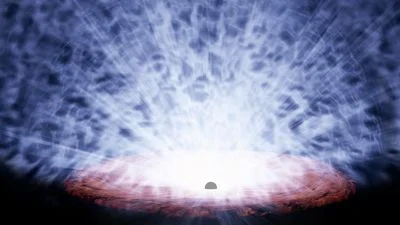
Supermassive Black Hole’s ‘Gas Bullets’ Shot at Near Light Speed: XRISM Mission Reveals Clumpy Quasar Winds
A cosmic storm is brewing at the heart of a quasar, and the effects are far more turbulent than previously imagined. The X-ray Imaging and Spectroscopy Mission (XRISM), a JAXA-led international space telescope, has unveiled a new understanding of outflows from quasars, specifically focusing on PDS 456, a quasar experiencing what researchers are calling a violent storm of plasma.

Quasars, characterized by supermassive black holes feeding voraciously at the core of galaxies, often spew out excess material at incredible speeds, sometimes outshining their entire host galaxy. Central to this phenomenon is the mechanism by which supermassive black holes gather material for their cosmic feast, frequently triggered by galaxy collisions that deliver matter to the central regions. This creates a feedback loop, with plasma ejections forming winds that span across the galaxy. However, the precise formation of these winds close to the black hole remains a mystery, until now.
XRISM's observations of PDS 456 have revealed that these quasar winds are not smooth and uniform but clumpy, resembling a rapid-fire stream of gas "bullets." These gas components, identified as five distinct entities, are propelled at speeds ranging from 20% to 30% of the speed of light.
“PDS 456 is a valuable laboratory for studying the very powerful winds produced by supermassive black holes in the local universe. This new observation has allowed us to measure the geometry and speed distribution of the wind with a level of detail that was unthinkable before the advent of Xrism,” said Valentina Braito, an INAF researcher in Milan. The bullet-like outflows release mass equivalent to 60 to 300 Suns annually, carrying over 1,000 times the energy of galactic-scale winds. However, unlike winds spanning thousands of light-years, these outflows originate incredibly close—within 0.1 light-years—to the black hole.
The implications are profound. These findings challenge existing theories of galaxy and supermassive black hole co-evolution. It is believed that every galaxy harbors a supermassive black hole at its center—objects with masses millions of times that of the sun. These gas bullets challenge the idea, by regulating the growth of black holes through feedback that limits the inflow of matter, and by injecting vast amounts of energy into their host galaxies, potentially shutting down star formation.
PDS 456, located 2.5 billion light-years away, with a black hole mass of over 1.5 billion Suns, offers a unique opportunity for detailed study. Researchers aim to compare PDS 456 with other quasars to determine if its behavior is typical or exceptional.
The study is published in the journal Nature.
This breakthrough is crucial for better understanding how galaxies and supermassive black holes evolve together. What other unexpected discoveries await within these violent cosmic storms? Share your thoughts and predictions in the comments below.